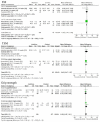Effects of Exercise and Nutritional Intervention on Body Composition, Metabolic Health, and Physical Performance in Adults with Sarcopenic Obesity: A Meta-Analysis
- PMID: 31505890
- PMCID: PMC6770949
- DOI: 10.3390/nu11092163
Effects of Exercise and Nutritional Intervention on Body Composition, Metabolic Health, and Physical Performance in Adults with Sarcopenic Obesity: A Meta-Analysis
Abstract
People with sarcopenic obesity (SO) are characterized by both low muscle mass (sarcopenia) and high body fat (obesity); they have greater risks of metabolic diseases and physical disability than people with sarcopenia or obesity alone. Exercise and nutrition have been reported to be effective for both obesity and sarcopenia management. Thus, we aimed to investigate the effects of exercise and nutrition on body composition, metabolic health, and physical performance in individuals with SO. Studies investigating the effects of exercise and nutrition on body composition, metabolic health, and physical performance in SO individuals were searched from electronic databases up to April 2019. Fifteen studies were included in the meta-analysis. Aerobic exercise decreased body weight and fat mass (FM). Resistance exercise (RE) decreased FM and improved grip strength. The combination of aerobic exercise and RE decreased FM and improved walking speed. Nutritional intervention, especially low-calorie high-protein (LCHP) diet, decreased FM but did not affect muscle mass and grip strength. In addition to exercise training, nutrition did not provide extra benefits in outcome. Exercise, especially RE, is essential to improve body composition and physical performance in individuals with SO. Nutritional intervention with LCHP decreases FM but does not improve physical performance.
Keywords: aerobic exercise; resistance exercise; supplementation.
Conflict of interest statement
The authors declare no conflict of interest. The sponsors had no role in the design, execution, interpretation, or writing of the study.
Figures





Similar articles
-
Effectiveness of early versus delayed exercise and nutritional intervention on segmental body composition of sarcopenic elders - A randomized controlled trial.Clin Nutr. 2021 Mar;40(3):1052-1059. doi: 10.1016/j.clnu.2020.06.037. Epub 2020 Jul 14. Clin Nutr. 2021. PMID: 32723507 Clinical Trial.
-
Effects of a nutrition plus exercise programme on physical function in sarcopenic obese elderly people: study protocol for a randomised controlled trial.BMJ Open. 2016 Sep 30;6(9):e012140. doi: 10.1136/bmjopen-2016-012140. BMJ Open. 2016. PMID: 27694489 Free PMC article. Clinical Trial.
-
Effectiveness of non-pharmacological interventions on the management of sarcopenic obesity: A systematic review and meta-analysis.Exp Gerontol. 2020 Jul 1;135:110937. doi: 10.1016/j.exger.2020.110937. Epub 2020 Mar 30. Exp Gerontol. 2020. PMID: 32240820
-
Effects of nutrition supplementation and physical exercise on muscle mass, muscle strength and fat mass among sarcopenic elderly: a randomized controlled trial.Appl Physiol Nutr Metab. 2021 May;46(5):494-500. doi: 10.1139/apnm-2020-0643. Epub 2020 Nov 20. Appl Physiol Nutr Metab. 2021. PMID: 33216623 Clinical Trial.
-
Nutritional and exercise interventions in individuals with sarcopenic obesity around retirement age: a systematic review and meta-analysis.Nutr Rev. 2023 Aug 10;81(9):1077-1090. doi: 10.1093/nutrit/nuad007. Nutr Rev. 2023. PMID: 36882046 Free PMC article.
Cited by
-
Detraining Effects on Muscle Quality in Older Men with Osteosarcopenia. Follow-Up of the Randomized Controlled Franconian Osteopenia and Sarcopenia Trial (FrOST).Nutrients. 2021 May 1;13(5):1528. doi: 10.3390/nu13051528. Nutrients. 2021. PMID: 34062828 Free PMC article. Clinical Trial.
-
Association of normal weight obesity with lifestyle and dietary habits in young Thai women: A cross-sectional study.Obes Pillars. 2023 Jan 26;5:100055. doi: 10.1016/j.obpill.2023.100055. eCollection 2023 Mar. Obes Pillars. 2023. PMID: 37990747 Free PMC article.
-
Usefulness of an Easy, Structured, and Home-Based Exercise Program to Improve Physical Performance and Quality of Life in a Patient's Cohort with Obesity.Obes Facts. 2023;16(5):507-513. doi: 10.1159/000533639. Epub 2023 Aug 18. Obes Facts. 2023. PMID: 37598666 Free PMC article.
-
Impact of Adiposity and Fat Distribution, Rather Than Obesity, on Antibodies as an Illustration of Weight-Loss-Independent Exercise Benefits.Medicines (Basel). 2021 Oct 8;8(10):57. doi: 10.3390/medicines8100057. Medicines (Basel). 2021. PMID: 34677486 Free PMC article.
-
Mapping Knowledge Landscapes and Emerging Trends of Sarcopenic Obesity in Older Adults: A Bibliometric Analysis From 2004 to 2023.Cureus. 2024 Jun 13;16(6):e62300. doi: 10.7759/cureus.62300. eCollection 2024 Jun. Cureus. 2024. PMID: 38873392 Free PMC article.
References
-
- Poirier P., Giles T.D., Bray G.A., Hong Y., Stern J.S., Pi-Sunyer F.X., Eckel R.H., American Heart Association. Obesity Committee of the Council on Nutrition, Physical Activity, and Metabolism Metabolism Obesity and cardiovascular disease: Pathophysiology, evaluation, and effect of weight loss: An update of the 1997 American heart association scientific statement on obesity and heart disease from the obesity committee of the council on nutrition, physical activity, and metabolism. Circulation. 2006;113:898–918. - PubMed
Publication types
MeSH terms
Grants and funding
LinkOut - more resources
Full Text Sources
Medical
Miscellaneous

